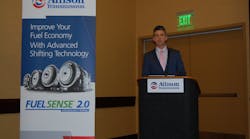INDIANAPOLIS. Allison Transmission plans to introduce a new upgraded software package for its heavy-duty full-automatic gearboxes in April this year: FuelSense 2.0 featuring what it calls DynActive Shifting.
John Coll, Allison’s senior vice president for global marketing, sales, and service, said during a press conference here at the 2017 National Truck Equipment Association (NTEA) Work Truck Show that according to the company’s data gleaned over 3 million miles of testing, FuelSense 2.0 can deliver between 2% and 6% worth of fuel savings depending on truck application compared to the original version of FuelSense released back in 2014.
“Over half of Allison transmissions today are delivered with FuelSense,” he explained. “Based on our extensive testing, we believe FuelSense 2.0 can deliver more fuel savings.”
The fuel savings potential of FuelSense 2.0 calculated by Allison based on truck duty cycle is as follows:
- Refuse: up to 6% savings
- Distribution: up to 6.3%
- Transit Bus: up to 4.3%
- Construction/dump truck operation: up to 2.3%
Ryan Milburn, executive director of embedded controls at Allison, said FuelSense 2.0 will be available in three distinct “packages” so fleets can better balance fuel economy and performance to their specific application needs: FuelSense 2.0, FuelSense 2.0 Plus and FuelSense 2.0 Max.
He explained that FuelSense 2.0 Plus and Max include an improved function called “Neutral at Stop,” which reduces or eliminates the load on the engine when the vehicle is stopped.
FuelSense 2.0 Max also includes Acceleration Rate Management, which mitigates aggressive driving by automatically controlling engine torque. Newly updated, in addition to five levels of control currently available, Milburn said it provides more “precision” by limiting vehicle acceleration to a customized rate.
He added that through a set of proprietary enhancements, the new DynActive Shifting aspect of FuelSense 2.0 – an DynActive is available on all three FuelSense 2.0 packages – provides an “infinitely variable combination of shift points” based on real-time operational data measured against what he dubbed “embedded powertrain modeling.”
“This is an evolution from table-based shift schedules,” Milburn explained. “DynActive is a ‘learning algorithm’ so it can set the ‘best’ shift schooled based on real-time operation inputs.”
Allison said FuelSense 2.0 is “ideally suited” for city bus, school bus, refuse, construction and distribution and can save an estimated $300 to $900 annually based on application and annual mileage in fuel savings per vehicle.
The company noted that FuelSense 2.0 packages will be available starting in mid-April but that aftermarket installation is not currently allowed in California or the CARB Heavy Duty Opt-in states of Maine, Pennsylvania and New Jersey.
Allison added that Autocar Trucks will be the first truck manufacturer to offer FuelSense 2.0 – installing this optional software package right into the transmission control module on Autocar’s main production line.
“A typical garbage truck burns 10,000 gallons of fuel a year. With FuelSense 2.0 Max, our customers can save over $1,500 per year in fuel costs at the current price of diesel,” noted Jim Johnston, Autocar’s president, in a statement. “That’s money that goes straight to the bottom line.”
He added that Autocar is taking orders effective immediately for FuelSense 2.0 in both diesel and compressed natural gas (CNG) applications and for both Allison 3000 Series and 4000 Series automatic transmissions.



